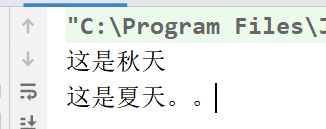枚举的使用与详解
一:枚举的引入
【1】数学:枚举法:
1<x<4
2<y<5
求x+y=6
枚举法:一枚一枚的列举出来。前提:有限,确定
【2】在java中,类的对象是有限个,确定的。这个类我们可以定义为枚举类。
举例:
星期:一二三四五六日
性别:男女
季节:春夏秋冬
【3】自定义枚举类:(JDK1.5之前自定义枚举类)
package com.mingyuanyun.enumdemo; /** * @Auther: wty01 * @Date: 2022/10/5 * @Description: com.mingyuanyun.enumdemo */ /** * 定义枚举类:季节 */ public class Season { private final String seasonName; //季节名称 private final String seasonDesc; //季节描述 //利用构造器对属性进行赋值操作: //构造器私有化,外界不能调用这个构造器,只能Season内部自己调用 private Season(String seasonName, String seasonDesc) { this.seasonName = seasonName; this.seasonDesc = seasonDesc; } //创建枚举类的有限的确定的对象 public static final Season SPRING = new Season("春天", "春暖花开"); public static final Season SUMMER = new Season("夏天", "烈日炎炎"); public static final Season AUTUMN = new Season("秋天", "硕果累累"); public static final Season WINTER = new Season("冬天", "冰天雪地"); //额外因素: public String getSeasonName() { return seasonName; } public String getSeasonDesc() { return seasonDesc; } //toString(); @Override public String toString() { return "Season{" + "seasonName='" + seasonName + '\'' + ", seasonDesc='" + seasonDesc + '\'' + '}'; } }
测试类:TestSeason
package com.mingyuanyun.enumdemo; /** * @Auther: wty01 * @Date: 2022/10/5 * @Description: com.mingyuanyun.enumdemo */ public class TestSeason { //这是一个main方法,是程序的入口: public static void main(String[] args) { Season summer = Season.SUMMER; System.out.println(summer/*.toString()*/); System.out.println(summer.getSeasonName()); }
package com.mingyuanyun.enumdemo2;
/**
* @Auther: wty01
* @Date: 2022/10/5
* @Description: com.mingyuanyun.enumdemo
*/
二、JDK1.5以后使用enum关键字创建枚举类:
package com.mingyuanyun.enumdemo2;
/**
* @Auther: wty01
* @Date: 2022/10/5
* @Description: com.mingyuanyun.enumdemo
*/
/**
* 定义枚举:季节
*/
public enum Season {
//创建枚举类的有限的确定的对象---->enum枚举要求对象(常量)必须放在最开始的位置上
SPRING("春天", "春暖花开"),
SUMMER("夏天", "烈日炎炎"),
AUTUMN("秋天", "硕果累累"),
WINTER("冬天", "冰天雪地");
//属性
private final String seasonName; //季节名称
private final String seasonDesc; //季节描述
private Season(String seasonName, String seasonDesc) {
this.seasonName = seasonName;
this.seasonDesc = seasonDesc;
}
public String getSeasonName() {
return seasonName;
}
public String getSeasonDesc() {
return seasonDesc;
}
@Override
public String toString() {
return "Season{" +
"seasonName='" + seasonName + '\'' +
", seasonDesc='" + seasonDesc + '\'' +
'}';
}
}(1)使用枚举类:
package com.mingyuanyun.enumdemo2;
/**
* @Auther: wty01
* @Date: 2022/10/5
* @Description: com.mingyuanyun.enumdemo2
*/
public class TestSeason {
public static void main(String[] args) {
Season winter = Season.WINTER;
System.out.println(winter);
//enum关键字对应的枚举类的上层父类是 :java.lang.Enum
//但是我们自定义的枚举类的上层父类:Object
System.out.println(Season.class.getSuperclass().getName());//java.lang.Enum
}
}(2)在源码中经常看到别人定义的枚举类形态:
package com.mingyuanyun.enumdemo3;
/**
* @Auther: wty01
* @Date: 2022/10/5
* @Description: com.mingyuanyun.enumdemo3
*/
public enum Season {
SPRING,
SUMMER,
AUTUMN,
WINTER
}为什么这么简单:因为这个枚举类底层没有属性,属性,构造器,toString,get方法都删掉不写了,然后案例来说应该写为:SPRING() 现在连()可以省略 就变成 SPRING
看到的形态就剩:常量名(对象名)
案例:
Thread中的枚举类:State
public enum State {
/**
* Thread state for a thread which has not yet started.
*/
NEW,
/**
* Thread state for a runnable thread. A thread in the runnable
* state is executing in the Java virtual machine but it may
* be waiting for other resources from the operating system
* such as processor.
*/
RUNNABLE,
/**
* Thread state for a thread blocked waiting for a monitor lock.
* A thread in the blocked state is waiting for a monitor lock
* to enter a synchronized block/method or
* reenter a synchronized block/method after calling
* {@link Object#wait() Object.wait}.
*/
BLOCKED,
/**
* Thread state for a waiting thread.
* A thread is in the waiting state due to calling one of the
* following methods:
* <ul>
* <li>{@link Object#wait() Object.wait} with no timeout</li>
* <li>{@link #join() Thread.join} with no timeout</li>
* <li>{@link LockSupport#park() LockSupport.park}</li>
* </ul>
*
* <p>A thread in the waiting state is waiting for another thread to
* perform a particular action.
*
* For example, a thread that has called <tt>Object.wait()</tt>
* on an object is waiting for another thread to call
* <tt>Object.notify()</tt> or <tt>Object.notifyAll()</tt> on
* that object. A thread that has called <tt>Thread.join()</tt>
* is waiting for a specified thread to terminate.
*/
WAITING,
/**
* Thread state for a waiting thread with a specified waiting time.
* A thread is in the timed waiting state due to calling one of
* the following methods with a specified positive waiting time:
* <ul>
* <li>{@link #sleep Thread.sleep}</li>
* <li>{@link Object#wait(long) Object.wait} with timeout</li>
* <li>{@link #join(long) Thread.join} with timeout</li>
* <li>{@link LockSupport#parkNanos LockSupport.parkNanos}</li>
* <li>{@link LockSupport#parkUntil LockSupport.parkUntil}</li>
* </ul>
*/
TIMED_WAITING,
/**
* Thread state for a terminated thread.
* The thread has completed execution.
*/
TERMINATED;(3)Enum类的常用方法:
package com.mingyuanyun.enumdemo3;
/**
* @Auther: wty01
* @Date: 2022/10/5
* @Description: com.mingyuanyun.enumdemo3
*/
public class TestSeason {
//这是一个main方法,是程序的入口:
public static void main(String[] args) {
//用enum关键字创建的Season枚举类上面的父类是:java.lang.Enum,常用方法子类Season可以直接拿过来使用:
//toString();--->获取对象的名字
Season autumn = Season.AUTUMN;
System.out.println(autumn/*.toString()*/);//AUTUMN
System.out.println("--------------------");
//values:返回枚举类对象的数组
Season[] values = Season.values();
for (Season s : values) {
System.out.println(s/*.toString()*/);
}
System.out.println("--------------------");
//valueOf:通过对象名字获取这个枚举对象
//注意:对象的名字必须传正确,否则抛出异常
Season autumn1 = Season.valueOf("AUTUMN");
System.out.println(autumn1);
}
}(4)枚举类实现接口:
1.定义一个接口:
public interface TestInterface {
void show();
}2.枚举类实现接口,并且重写show方法:
public enum Season implements TestInterface {
SPRING,
SUMMER,
AUTUMN,
WINTER;
@Override
public void show() {
System.out.println("这是Season....");
}
}测试:
public class Test {
//这是一个main方法,是程序的入口:
public static void main(String[] args) {
Season autumn = Season.AUTUMN;
autumn.show();
Season summer = Season.SUMMER;
summer.show();
}
}上面发现所有的枚举对象,调用这个show方法的时候走的都是同一个方法,结果都一样:

但是现在我想要:不同的对象 调用的show方法也不同:
package com.mingyuanyun.enumdemo4
import java.sql.SQLOutput;
public enum Season implements TestInterface {
SPRING{
@Override
public void show() {
System.out.println("这是春天。。。");
}
},
SUMMER{
@Override
public void show() {
System.out.println("这是夏天。。");
}
},
AUTUMN{
@Override
public void show() {
System.out.println("这是秋天");
}
},
WINTER{
@Override
public void show() {
System.out.println("这是冬天");
}
};
/*@Override
public void show() {
System.out.println("这是Season....");
}*/
}测试类:
public class Test {
//这是一个main方法,是程序的入口:
public static void main(String[] args) {
Season autumn = Season.AUTUMN;
autumn.show();
Season summer = Season.SUMMER;
summer.show();
}
}
(5)实际应用
package com.mingyuanyun.enumdemo5;
/**
* @author : msb-zhaoss
*/
public class Person {
//属性:
private int age;
private String name;
private Gender sex;
public int getAge() {
return age;
}
public void setAge(int age) {
this.age = age;
}
public String getName() {
return name;
}
public void setName(String name) {
this.name = name;
}
public Gender getSex() {
return sex;
}
public void setSex(Gender sex) {
this.sex = sex;
}
@Override
public String toString() {
return "Person{" +
"age=" + age +
", name='" + name + '\'' +
", sex='" + sex + '\'' +
'}';
}
}public enum Gender {
男,
女;
}public class Test {
//这是一个main方法,是程序的入口:
public static void main(String[] args) {
Person p = new Person();
p.setAge(19);
p.setName("lili");
p.setSex(Gender.男);//传入枚举类Gender的对象:-->在入口处对参数进行了限制
System.out.println(p);
}
}
还可以通过枚举结合switch处理:
public class Test02 {
//这是一个main方法,是程序的入口:
public static void main(String[] args) {
Gender sex = Gender.男;
//switch后面的()中可以传入枚举类型
//switch后面的():int,short,byte,char,String ,枚举
switch (sex){
case 女:
System.out.println("是个女孩");
break;
case 男:
System.out.println("是个男孩");
break;
}
}
}




 浙公网安备 33010602011771号
浙公网安备 33010602011771号